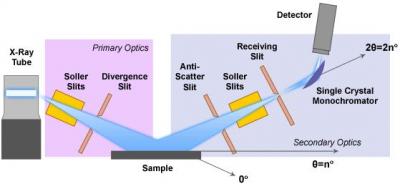X-ray diffraction (XRD) is a powerful nondestructive technique for characterizing crystalline materials. It provides information on structures, phases, preferred crystal orientations (texture), and other structural parameters, such as average grain size, crystallinity, strain, and crystal defects. X-ray diffraction peaks are formed by constructive interference of a X-ray beam at specific angles from each set of lattice planes in a sample. The peak intensities are determined by the distribution of atoms within the lattice. Therefore, the x-ray diffraction pattern is the fingerprint of periodic atomic arrangements in a given material. A search of the International Centre for Diffraction Data (ICDD) standard database of x-ray diffraction patterns enables quick phase identification for a large variety of crystalline samples.
Main Applications of XRD Analysis:
- Identification/quantification of crystalline phase
- Measurement of average crystallite size, strain, or micro-strain effects in bulk and thin-film samples
- Quantification of preferred orientation (texture) in thin films, multi-layer stacks, and manufactured parts
- Determination of the ratio of crystalline to amorphous material in bulk materials and thin-film samples
